HOPE not hate uses cookies to collect information and give you a more personalised experience on our site. You can find more information in our privacy policy. To agree to this, please click accept.
2020 WILL forever be marred by the global pandemic. We were locked in our homes, forced to hide our faces, as millions around the world…
2020 WILL forever be marred by the global pandemic. We were locked in our homes, forced to hide our faces, as millions around the world lost their lives or were left with debilitating symptoms. Many millions more have lost jobs, struggled to pay their rent or mortgages, and been left isolated and lonely.
As we enter 2021, the death toll from the disease continues to rise, though the arrival of numerous vaccines has provided a much needed glimmer of hope. However, the ramifications of the pandemic will continue to be felt for years to come, not least the impending economic crisis set to grip the world economy.
Yet, it has by no means been all bad news. In the face of these many tragedies communities have come together, neighbours and strangers helping one another and examples of heart-breaking sacrifice, love and hope.
2020 was also a year of anger, with millions of people around the world hitting the streets to chant “I can’t breathe”, protesting against the murder of an African American man, George Floyd, by a white Minneapolis police officer and demanding racial justice. Black Lives Matter (BLM) protests erupted in over 60 countries across all seven continents, pushing the issues of racism and systemic inequality up the political agenda. Statues fell, street names changed and national conversations about racism, imperial and colonial legacies filled column inches and TV screens.
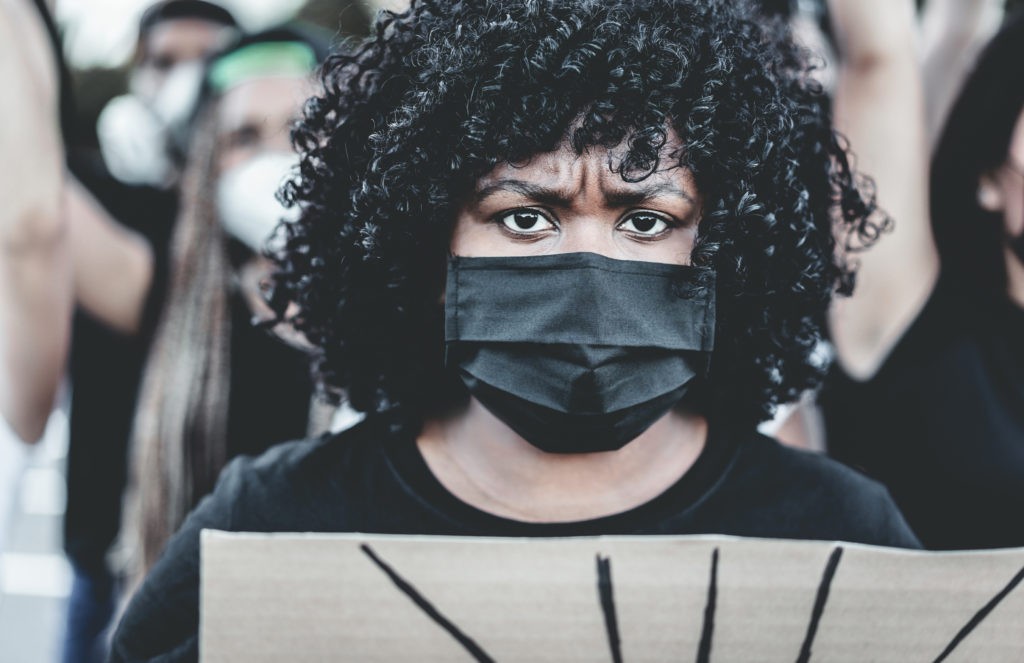
The need for racial justice is evident in exclusive polling of BAME (Black Asian and Minority Ethnic) Britons for this State of HATE report. Almost half of respondents (45%) had either experienced or witnessed racial abuse over the last 12 months and 40% had experienced or witnessed racial violence.
For the British far right, the last year has been a difficult one. Locked in their homes like everyone else, their ability to organise offline, meet and campaign has been severely curtailed. However, it was also a year of opportunities. With everyone locked indoors on their computers, the chances of reaching and radicalising new people online grew.
Exploiting the gateways offered by digital technology, far-right groups continued to proselytise, promote and recruit via online gaming, voice chats on social media and even in (online) film clubs. Some also tried to exploit home schooling as a way of pushing their divisive politics towards young people.
Importantly, with the explosion of conspiracy theory content, last year the far right sought to exploit new ways of radicalising others by exploiting various (non extreme-right) conspiracy theories related to COVID-19.
Because the unique circumstances of 2020 demanded innovation, many older, traditional far-right groups and individuals appeared to do very little, while the younger, more tech-savvy elements of the movement made a much greater impact.
In recent years HOPE not hate has increasingly talked of the threat posed by the ‘post-organisational’ far right: thousands of individuals across the globe, offering micro-donations of time and sometimes money to collaborate towards common far-right goals.
Although this has not replaced traditional far-right organisations with their leadership structures and formal memberships, the rapid growth of the digital landscape – and especially social media – has helped foster the growth of an alternative organising model. In turn, this has led to the creation of a growing number of decentralised and transnational far-right movements. This trend continued and even accelerated over the past year.
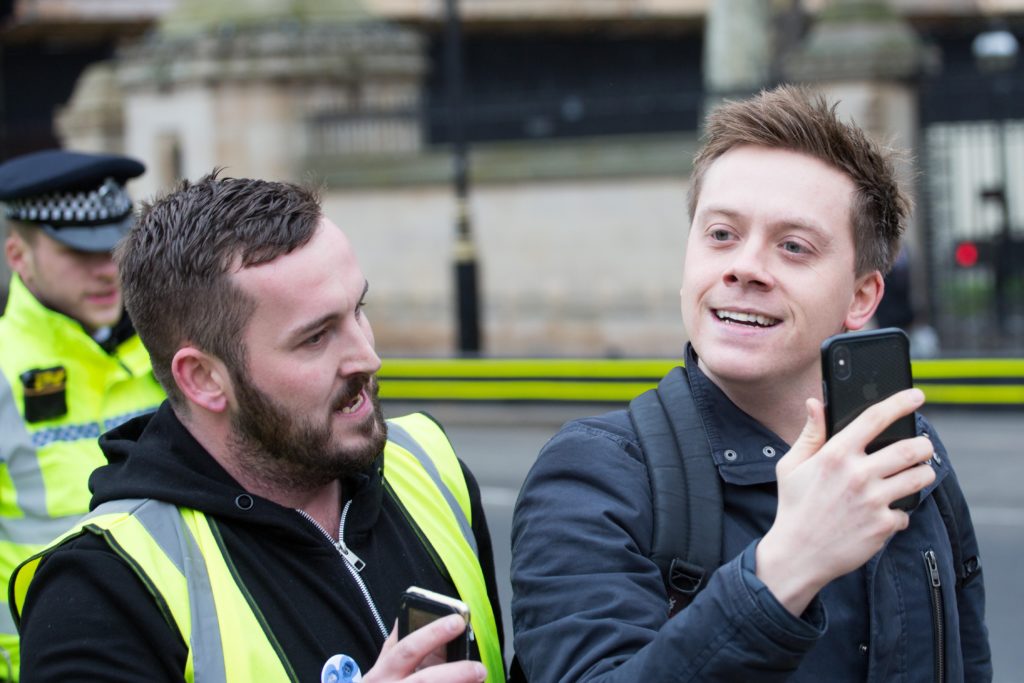
With Brexit delivered, the far right began looking for issues around which it could muster support. Unsurprisingly, the primary shift was a return to anti- migrant politics, spurred on by a Home Secretary who appeared determined to talk (very) tough on immigrants, while simultaneously demonising so- called “activist lawyers” working on immigration cases.
A small group of far-right ‘citizen journalists’ capitalised on the anti-migrant firestorm that splashed across tabloid media, as a growing number of migrants attempted the fraught Channel crossing between southern England and France. In a trend that began years ago, but accelerated in 2020, many of the figureheads that are now directing much of the UK far- right scene have begun to self-identify as “journalists”. In an age when trust in traditional media outlets is low and increasing numbers of people get their information via social media, the rise of these far-right ‘citizen journalists’ poses a growing danger.
Last year, a handful of these figures spent large amounts of time filming the arrival of migrant boats and various locations used to house the arriving migrants, including hotels. These videos, which occasionally included footage of the so-called ‘journalists’ chasing arrivals, quickly spread across far-right social media platforms and whipped anti- immigrant activists into a peak of anger. Each new video served to confirm the far right’s already existing (and twisted) belief that Britain was being invaded.
The daily drip-drip of anti-migrant content they produced and fed into far-right online spaces forced the issue up the agenda, until more formal far-right organisations including Britain First and For Britain enthusiastically jumped on the issue with their own demonstrations and migrant hotel invasions. Here we saw something new: post-organisational (far-right) ‘citizen journalists’ setting the agenda for traditional far-right parties.

The second primary campaign issue for the British far right during 2020 was their racist reaction to the Black Lives Matter (BLM) protests which spread across Britain (and many other countries) in the wake of George Floyd’s murder.
There were over 30 protests by football hooligans and far-right activists to “counter” these BLM protests, some numbering many hundreds and, in the case of London, attracting as many as 5,000 people. While claiming purely to “defend” statues and monuments, several of these protests turned to violence, as the hooligans clashed with police and BLM supporters.
Racial nationalist groups and individuals used the BLM protests to push their existing political platform, built around concepts of race, to a wider audience. In August, there were 66 White Lives Matters protests organised across the UK by the far right group Patriotic Alternative, which emerged as a rising far-right force last year.
Additionally, other elements of the far right that had traditionally distanced themselves from open racial politics, promoting instead ‘cultural nationalism’, more openly took to explicit racial politics. Most notable here was Stephen Yaxley-Lennon [aka Tommy Robinson] who jumped on the BLM issue in the summer, providing a brief moment of relevance in a year otherwise dominated by legal woes.
Whether this shift towards more overt racial politics becomes permanent remains to be seen, but in the short-to-medium term we are likely to continue to see cultural nationalism cede ground to racial nationalism within the far right. With the combination of anti-black racism and anti-migrant politics as the twin prongs of its platform in 2020, the UK far right looks more akin to the far right of decades gone by, rather than the scene we have got used to in recent years.
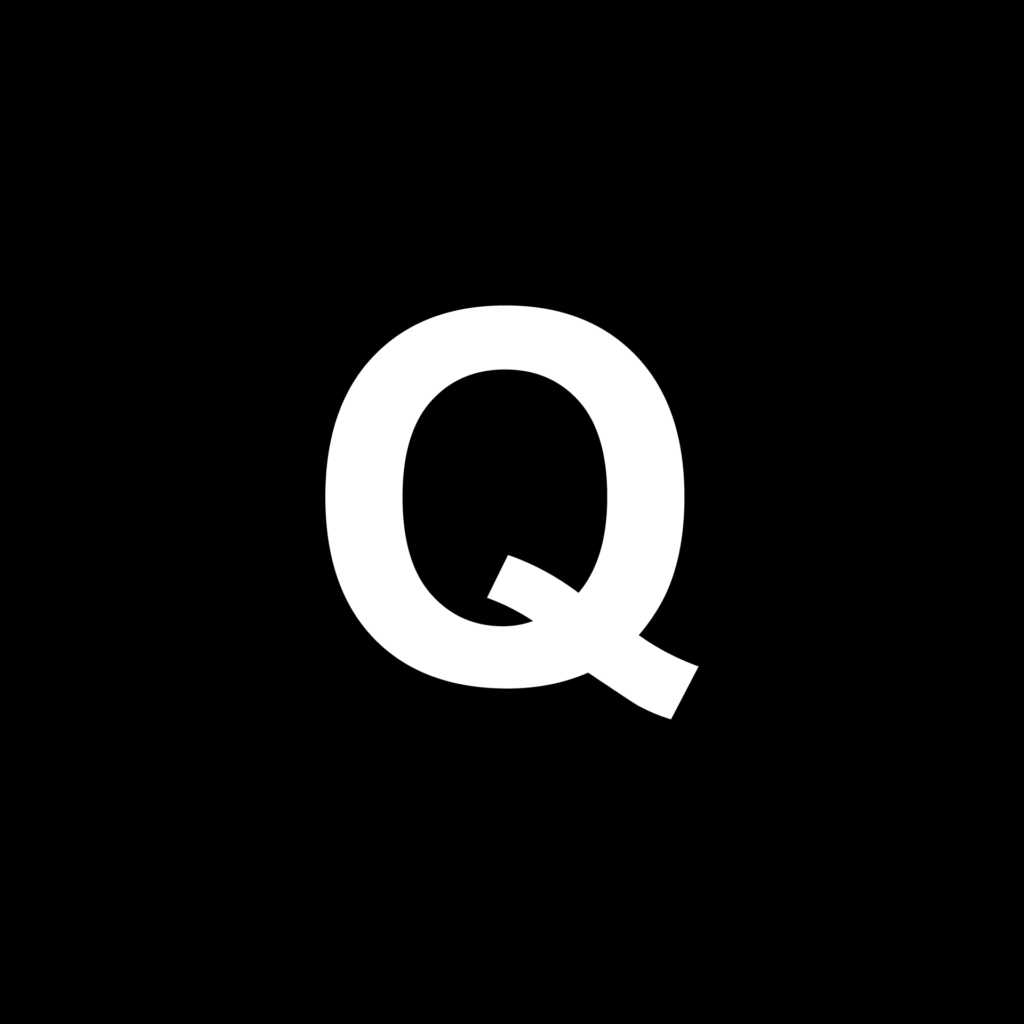
The arrival of the coronavirus pandemic proved an incredible boon to conspiracy theories and theorists, as a confused and anxious population sought explanations for the shocking calamity of COVID-19 and the resulting lockdowns.
An Ofcom report published in June 2020 found that during the first lockdown, Britain’s internet users spent an average of four hours and two minutes online each day, 37 minutes more than they did in January. While young people averaged five hours and four minutes per day, the highest percentage increase was among over-54s who were online 24% more than they were in January. It’s perhaps unsurprising that in these circumstances, more people came across and even believed conspiracies and disinformation.
From March onwards we saw meteoric increases in engagement with conspiracy content online, from anti- vaccine to anti-5G content, as well as QAnon pages and groups. HOPE not hate’s polling repeatedly found alarming awareness of conspiracy theories among the British public. A third of Britons have read or seen videos claiming that “elites in Hollywood, governments, the media and other powerful positions are secretly engaging in large scale child trafficking and abuse” – a key component of the QAnon conspiracy.
Forty percent (40%) had heard or seen claims that “Coronavirus is a bio-weapon intentionally spread by the Chinese state”, while 35% said that they had come across the conspiracy that “Coronavirus has been intentionally released as part of a “depopulation” plan orchestrated by the UN or New World Order.”
“Telegram continues to be the most important platform tying the violent elements of the British far right closer together“
While thankfully far fewer people actually believe these conspiracies, the levels are still worryingly high. Seven percent (7%) of Brits think that it is definitely true that “elites in Hollywood, governments, the media and other powerful positions are secretly engaging in large scale child trafficking and abuse”, with a further 15% saying it is probably true.
Four percent (4%) think it is definitely true that “the Covid-19 vaccine will be used maliciously to infect people with poison”, with a further 11% saying it is probably true.
CONSPIRACY INFLUENCERS
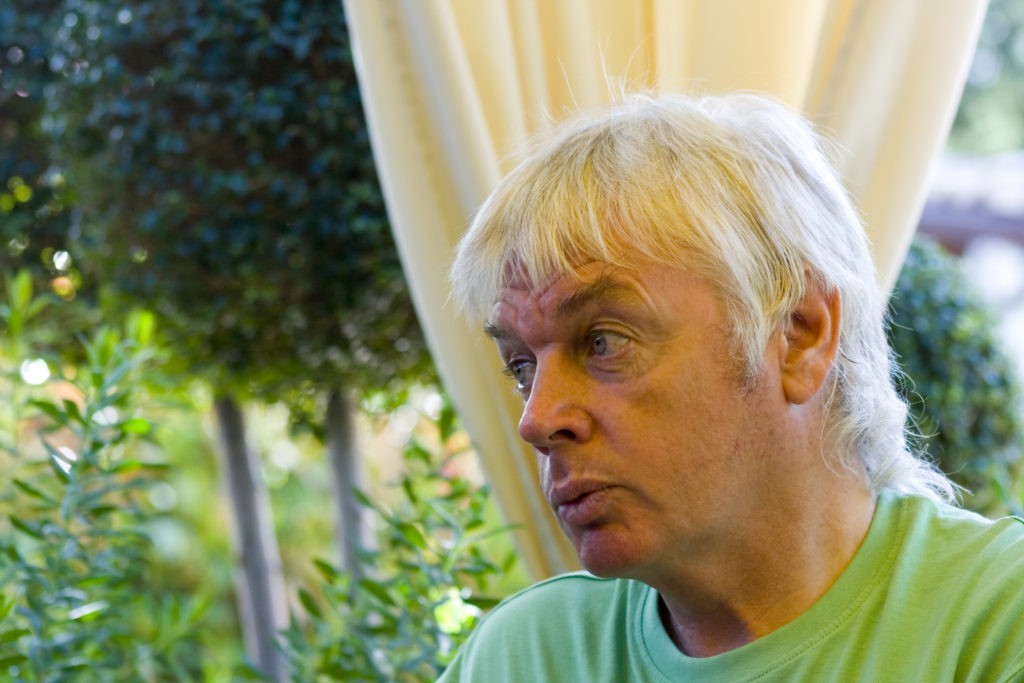
An early beneficiary of this upsurge of interest in conspiracy theories was former BBC sports presenter David Icke, whose videos denouncing the pandemic as a hoax and blaming 5G internet were viewed by millions of people in the early days of the outbreak.
From summer onwards, a small but highly active network of conspiracy-minded anti-lockdown groups emerged led by the likes of climate-sceptic Piers Corbyn and anti-vaxxer Kate Shemirani, organising protests in towns and cities across the UK on a weekly basis.
Of the dozens of anti-lockdown protests across the UK, the largest were in London, where up to 10,000 people gathered. In addition to the size, the protests drew in a lot of young and middle-aged women, many apparently new to protesting.
This broad array of people was mirrored online. David Icke had 780,000 followers on Facebook, 900,000 on YouTube and 230,000 on Twitter. Fortunately, he’s now been removed from all these platforms. Stand Up X, one of the most energetic conspiracy street movements in the UK, had 40,000 followers on Facebook before it too was taken down and The Light, a self-styled “truthpaper”, claims to print 100,000 copies per edition.
As the year went on, the imported American conspiracy theory QAnon began to play an increasingly large role in the UK scene, with its proponents
playing key roles in anti-lockdown and anti-vaccine campaigning, as well as developing a own street movement protesting against child trafficking supposedly being carried out by an imagined cabal of elite Satanic paedophiles.
Our State of HATE report reveals that one of the most important QAnon advocates is UK-based Martin Geddes, who had 250,000 Twitter followers. Another QAnon advocate and all-round conspiracy theorist is Simon Parkes, whose YouTube channel jumped from 50,000 subscribers early in the year to an astonishing 670,000 in the tumultuous days following the US election.
Another Brit-born QAnon vlogger is Charlie Ward, who reached 170,000 subscribers on his YouTube channel by mid-September and, after his page was subsequently removed, migrated to the video hosting site Bitchute where he currently has over 106,000 subscribers.
Our polling found that at its autumn peak, 3.2% of British people strongly supported QAnon, while a further 2.5% declared themselves soft supporters. While this level of support was to drop after President Trump’s election defeat and the storming of the Capitol, the relatively high support for something that has been declared a “domestic terrorism” threat by the FBI is deeply concerning.
The street protests dwindled as the year went on, with frequent arrests and worsening weather taking its toll on morale. Unsurprisingly, the far right was closely linked to the anti-lockdown and conspiracy theory scene more generally, with major figures like Yaxley-Lennon adopting the language of the conspiracy theory movement.

The emergence of Patriotic Alternative (PA) was one of the most notable developments on the far-right scene in 2020. Patriotic Alternative is a white nationalist, neo-nazi group created in 2019 by Mark Collett, former head of publicity for the British National Party (BNP), and Laura Towler, a vlogger and former editor at the far-right site Defend Europa.
Before its various social media bans in early 2021, PA’s Facebook group had nearly 18,000 likes. Despite lockdown the group remained active throughout the year and held numerous large campaign days. For a period it appeared that PA was managing to unite much of the traditional, fascist far right in Britain, which had splintered and been in decline for some time. That said, many had also been at pains to distance themselves from PA due to its perceived extremeness. There have been a number of damaging internal fights, too. So while the group has grown quickly into one of the major players on the UK far right scene, it is unlikely to grow significantly in the coming year.
The traditional far right has become even more irrelevant than it has in recent years. The death of veteran fascists such as Richard Edmonds and Eddie Morrison exemplified the ending of an era, both in terms of organisations but also people. The BNP is kept afloat as a means to cash in on wills, while the National Front (NF) now barely exists. A range of smaller nazi groups all-but-disappeared, such as the Racial Volunteer Force and Combat 18, while others, such as Blood and Honour, continue to be in steady decline.
On the more moderate end of the far-right spectrum, the populist radical-right parties had something of a rootless, rudderless year. Having united around the pro-Brexit cause for the previous five years, the UK’s exit from the EU in January 2020 forced Britain’s populist radical right to seek out new crusades and rallying cries. This search was complicated by the arrival of the coronavirus pandemic and public health measures to prevent it, which did not provide an easy platform to exploit.
Nigel Farage’s supposed retirement from politics post-Brexit will challenge those following in his wake, although polling suggests Boris Johnson has sapped a great deal of the electoral appeal once provided by Farage’s movements.
Despite the efforts of some on the pro-Brexit right to generate a populist opposition to lockdown policy and paint its proponents as “out of touch elitists”, all segments of the British public have remained overwhelmingly supportive of government interventions, and the arrival of the vaccine looks to have settled that debate for good.
As with other elements of the far right, the radical right sought to jump on the anti-BLM mood and anti-migrant politics through the lens of the “culture war”, with emotive talk about “woke ideology” and “cancel culture” – ill-defined terms that fuelled a suitably emotive and fractious debate to replace the Brexit wars. None of these topics have yet provided a visible boost to the electoral prospects of the radical right, however, with Reform UK support standing at 3% and UKIP less than 1% in recent polling. The arrival of actor Laurence Fox’s Reclaim party split these ‘culture warriors’ even further. They are also undermined by the increasing mainstreaming of far-right narratives by Conservative party politicians, such as Home Secretary Priti Patel.
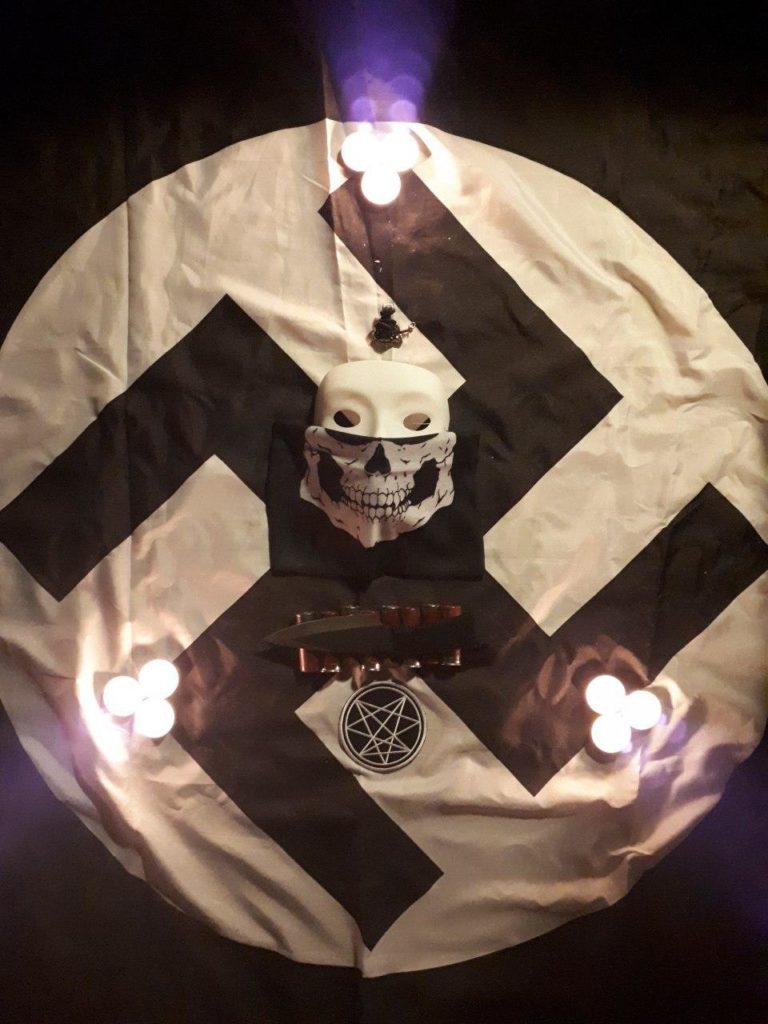
However, while the electoral far right remains in the doldrums, with little hope of posing a genuine threat in the coming years, it would be wrong to say the far right as a whole is currently irrelevant. Measuring the far-right threat by its votes has always been a myopic approach, particularly when it takes just one extremist to plan or carry out violence or a terror attack.
During 2020, 12 people either in far-right groups or influenced by far-right ideology were convicted of terrorist offences. They included Paul Dunleavy, who was 16 at the time of his arrest and was sentenced to five years and six months in prison for preparing acts of terrorism and possessing terror manuals. Filip Golon Bednarczyk, 26, was sentenced to four years in prison after admitting one count of possessing explosives and seven counts of possessing terrorist documents.
Four others were convicted for membership of National Action (NA), a proscribed terrorist organisation. They included Mark Jones, NA’s former London organiser who had close personal links to the neo-nazi group linked to five murders in the US, Atomwaffen Division, and who had also visited the nazi Azov Battalion in Ukraine.
“We saw meteoric increases in engagement with conspiracy content online.”
Reflecting a trend in recent years, several of those convicted were teenagers. Jack Reed, from Durham, was sentenced to six years and eight months in prison for preparation of terrorist acts, disseminating a terrorist publication, possessing an article for a purpose connected with terrorism and three counts of possessing a document or record containing information likely to be useful to a terrorist. Reed was just 15 at the time he committed these offences.
More disturbingly, Reed incorporated a sadistic nature to his political outlook. In a separate trial, he was convicted of sexually abusing a minor as well as the family dog. Like many other recent nazis convicted of terrorism, Reed was influenced by, among others, the satanic nazi group, the Order of Nine Angles (O9A).
Another O9A-linked nazi convicted of terrorism was Harry Vaughan, who pleaded guilty to 14 terror offences and two of possessing indecent images of children. He was also an activist with the banned Sonnenkrieg Division (SKD).
Given that he uploaded self-made propaganda images to the SKD, posting a series of weapons and explosives manuals online and possessing videos of young boys being raped, Vaughan inexplicably escaped prison.
Vaughan’s light sentence, mirroring that of 23-year-old Luke Hunter, who was jailed for just over four years after being convicted of a string of terror offences, has raised some concern. Both were drawn from very comfortable middle-class backgrounds (Vaughan was a pupil at the elite Tiffin Grammar School, while Hunter’s father was a senior officer in Counter- Terror Command and his mother was an executive at Johnson & Johnson) and both were actively involved in encouraging others to commit terrorist offences.
It is hard to believe that Islamist terrorists would have been given such lenient sentences.
In August 2020, HOPE not hate exposed another British nazi terrorist gang, The British Hand, led by a 15-year-old teenager. He and two others linked to the group are now awaiting terror charges. In this report we also expose the National Partisan Movement, an international youth-led nazi group, which boasts 70 supporters from 13 countries, including the UK.
Noteworthy is also their focus on transgender people. Over the last years we have seen increasingly violent anti-trans rhetoric in fascist online communities. For the National Partisan Movement, trans people and the wider LGBT+ community are the focus of several of their first pieces of propaganda.
Telegram continued to be the platform of choice for the terror-advocating far right in the UK in 2020. While other platforms are used alongside it both for organising and outreach, Telegram continues to be the most important platform tying the violent elements of the British far right closer together. With its relative ease-of-use and sign up, and commitment to secrecy, it lowers the hurdle to engage with violent groups and allows individuals to easily receive a constant stream of violent propaganda and immerse themselves into virulently racist communities. Telegram has done little to stem the use of its platform for these groups.

2020 was a difficult year for the traditional far right, but one of opportunities for the more tech-savvy groups and conspiracy theorists.
Of concern is the greater opportunity for far-right growth over the coming year or two. The health impact of COVID-19 will soon be eclipsed by the economic fallout from the pandemic, both as the furlough scheme ends here in the UK and as unemployment increases. In the not-too-distant future, the Government will be reducing public spending and increasing taxes in order to reduce the huge deficit. As history has so often proved, economic hardship and pessimism can lead to a climate of fear and political hate.
Two other factors could potentially help the far right going forward. First is what happens to all those people who were introduced to conspiracy theories during the pandemic, especially those exposed to QAnon. While most will probably drift back to their normal lives, some will undoubtedly carry on down the rabbit hole, potentially to more extreme and dangerous conspiracies.
Then there is the impact of Brexit. While Brexit has been delivered and many of those campaigning for it have stood down (including Nigel Farage), the longer- term economic and the constitutional impacts are still to be truly felt. Brexit has increased the likelihood of the Scots pushing for a new independence vote north of the border, while the Northern Irish protocol has led to a virtual border in the Irish Sea and deeply rattled Unionists and Loyalists, raising the prospect of a border vote there too.
What impact the possible break-up of the United Kingdom has on the English remains to be seen, but the likelihood is that it will lead to an upsurge in a more bitter English nationalism. Given how the far right has repeatedly attracted support from those who identify as “English”, a constitutional crisis is likely to be good news for the extremists – and bad news for everyone else.
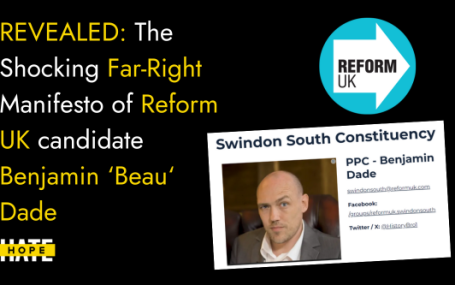
A Reform Party candidate fantasised about deporting “millions” of British citizens to “rid itself of the foreign plague we have been diseased with”. UPDATE: Reform…